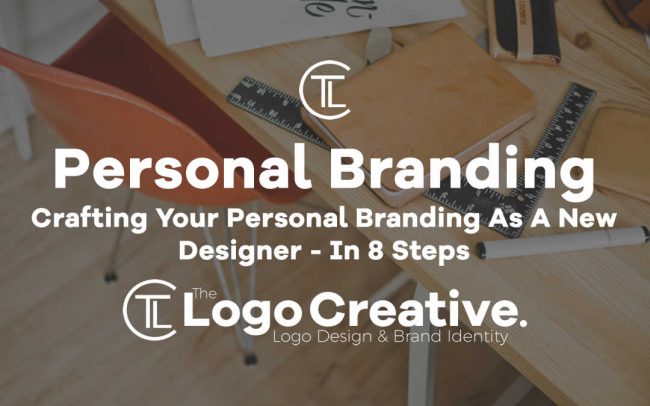Having a strong personal brand is crucial if you want to build a successful design career.
When you’re applying to jobs or reaching out to clients, a strong personal brand can help make you more memorable, showcase your style and tone of work, and convince people that you’re truly passionate about design outside of your 9-5 job. It also shows that you have an opinion or point of view about design and are willing to boldly attach that opinion to yourself for everyone to see!
Imagine you’re an employer looking through hundreds of design portfolios every day, searching for the perfect candidate to add to your design team. You decide whether or not to pass on most portfolios within about 10 seconds of landing on their homepage. Either their work itself is not strong enough or their homepage is messy, confusing, or inconsistent. Some of the people you pass on might even have a personal logo at the top of their homepage, but a quick glance tells you that this logo is not consistent with their work and was clearly created without much thought or process.
Your personal branding, just like any other strong design project in your portfolio, should follow a design process. This process should be the same one that you go through when doing a branding project for a client. You need to spend time thinking about what you want your branding to say about you, sketching ideas, refining a few of them, and then choosing typography and a color palette that matches.
Follow the 8 steps in this article and you’ll be well on your way to a unique and instantly recognizable personal brand! And if you ever need extra help building your portfolio or personal branding, check out our Design Portfolio Starter Kit.
Table of Contents
Step 1: Research It
- Look at the personal logos and brands of other designers, as well as use of consistent
color and typography across their websites. Take note of elements that you like and start to jot down any ideas you have for your own branding. A few sites to look at for inspiration are Krop, Dribbble, Behance, and even Twitter. - Think about the common trends you see in personal logos and brand identities of other designers, particularly designers in your field or niche. Are there any main trends or cliches that you want to steer away from?
- Think about your own career goals. What are your strengths? What kind of work do you want to focus on? What do you want employers to know about your specialties from a quick glance at your portfolio site homepage? For example, if you’re a minimalist designer, you’d likely want a sleek and simple personal brand identity, whereas if you focus on complex digital illustration, you’d want a more colorful and nuanced logo and set of icons to showcase that strength.
- Think about the types of companies you want to work for and consider what they value. You shouldn’t create a personal brand for any specific company, but looking at the brands of the types of companies and industries you admire is a good way to see how other designers have used branding to visually showcase a particular business’s focus or style.
Step 2: Moodboard It
- First, write 10 words that speak to your personal design style or strengths. Then write down 10 words that speak to the voice and feel of the brand you hope to design.
- Second, write down 10 words that you want employers to feel when they look at your personal branding.
- Next, write down 5 personality traits your brand would have if it were a person. These can be specific personality traits or even colors that symbolize that personality.
- After that, narrow each list down to three keywords to help drive your visual research. Use the words from these exercises as inspiration for the types of images you’ll use to create your moodboard.
- Now, create your moodboards! Collect imagery that speaks to the tone, brand voice, color palette, and typography style you want to achieve. Then, arrange it into a cohesive moodboard to inform your brainstorming process. It’s often helpful to break out visual elements into separate moodboards for typography and type lockups, color, and layout.
- Finally, with the help of your moodboard, begin to brainstorm ideas for a logo concept. Think about ideas for a type of logo that will speak to the identity that you want to cultivate. Think about whether you want a purely graphic logo or one that utilizes typography more heavily. Write down any ideas, concepts, or thoughts that pop into your mind.
Step 3: Sketch It
- This is the time to sketch out all of your ideas — good or bad! Sketch out 10 ideas in 10 minutes, focusing on getting across your main idea (you can fill in details later based on which concepts you think are strongest). Anything that crosses your mind, get it on paper. Over time you will begin to find some strong ideas evolving. These sketches can be small thumbnails that focus on getting the basic idea across – they don’t need to be too detailed.
- Pick a few of your favorite designs and begin refining them. Perhaps that means opening up Illustrator and starting to create vector versions.
Step 4: Think about typography
- After you’ve refined your best ideas, you want to begin to consider typography in the logo. Is it handdrawn? Is it an existing font? Are you altering an existing font or creating a new one? Write down your thoughts and then start researching different typefaces that could work for the branding of this project. This is particularly important if your logo incorporates your full name or initials. Look here for font inspiration.
- You might also want to consider having a simple tagline under your logo or name on
your portfolio site that says what you do in 2-5 words (e.g. “Jessica Smith – Minimalist Web Design”). When choosing typography, be sure not to pick more than 2 fonts so as not to overwhelm visitors. If you decide to write a tagline, write a few options and pick your favorite. Be as descriptive as possible in as few words as possible.
Step 5: Think about color
- Based on your moodboard, research, and logo design, how do you want to use color to showcase yourself? Look here for color inspiration and choose 2-4 primary colors for your brand. Apply them to the logo design.
Step 6: Ask for feedback
- After refining digitally, show your designs to a friend or mentor and ask for feedback. Conducting user research is a crucial part of the design process, and you should show your work to others as often as possible to get feedback from an objective source. If they have specific feedback, ask them why they feel that way and try to understand what about your design isn’t conveying what you wanted it to convey.
Step 7: Sketch icon and texture ideas
- Think about what kinds of icons you’ll need on your website. Are they going to be clickable icons that lead visitors to each of your different pages? Or will they be used to showcase your specific strengths or industry interests? Sketch 10 ideas for icons in 10 minutes. Next, based on your icons, consider any textures you might want to design for your portfolio site or personal branding as well. These could be simple illustrations that get combined to form a background texture, or even your icons repeated over and over.
- Pick a few of your favorite ideas and begin refining them. After refining and adding color, show them to a friend or mentor for feedback. Remember to always iterate and make sure that other people are seeing your designs the way you want them to be seen and interpreted!
Step 8: Finalize
- Make any necessary adjustments based on feedback, and finalize your logo lockup, typography picks, colors, and overall look and feel for your personal brand. Create a one-page Brand Guideline for yourself.
- Ensure that when you create your portfolio website or any other personal collateral (e.g. business cards, resume, cover letter, etc.), you apply your personal style guide consistently across all of them. The color palette you choose, the textures you create, the icons you apply, and the typography you use should all be consistent across all of your channels. In other industries, employers might not notice inconsistencies but if you’re applying for design jobs, consistent presentation across channels is yet another amazing way to stand out from your peers.
- Create your final Style Guide, using all of your textures, typography, logo, and color palette.
You’re done! You now have a fully built personal brand, using the same process that a real-world client project would have used. Congrats! Now that you’ve got a beautiful personal brand, you should apply it across your portfolio site and online channels. If you need help building up your portfolio, check out the portfolio building toolkits and bootcamps at RookieUp Below!
- Portfolio Starter Kit
- Career Bootcamps
- Build Your Portfolio Bootcamp
- Get A Design Job Bootcamp
- Become A Freelancer Bootcamp

Author Bio
Alec McGuffey is the co-founder of RookieUp, a design education platform that offers short-term bootcamps and portfolio-building tools to give aspiring designers everything they need to build an amazing design portfolio and launch their design career. RookieUp.com


